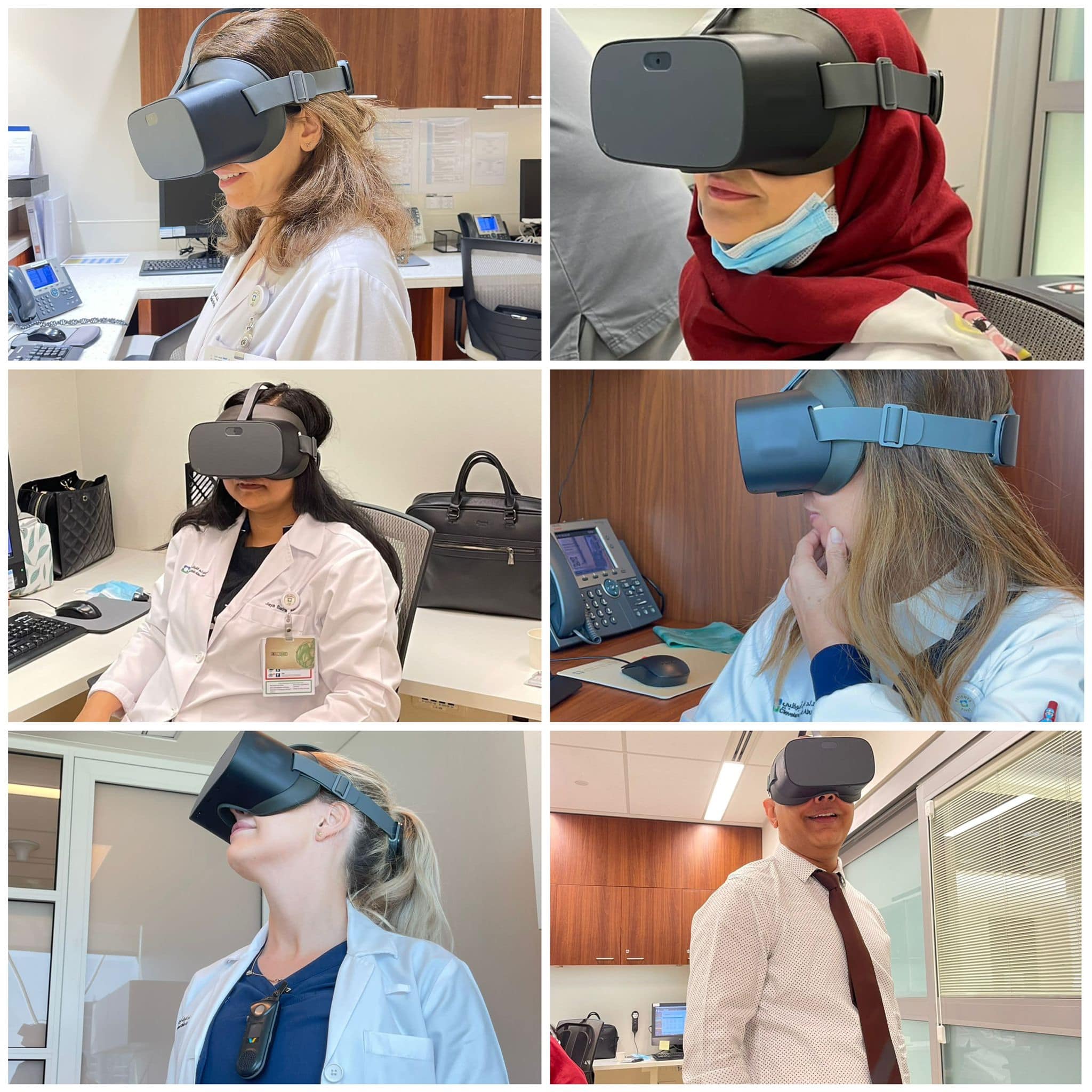Virtual Reality in Pain Management & Rehabilitation: An Update
Cite as: Bhayani S, Verma A, Chauhan H, et al. Virtual reality in pain management & rehabilitation: an update. ASRA Pain Medicine News 2024;49. https://doi.org/10.52211/asra020124.013.
Chronic pain affects millions of people worldwide, significantly impacting their quality of life and causing physical, emotional, and social challenges. Unfortunately, many patients may not respond to existing conventional treatment options that we offer. Originally an invention for entertainment with immersive experience, Virtual Reality (VR) has slowly and progressively been used in clinical medicine, more so in pain management and rehabilitation.1
VR is a technologically advanced system that gives the user an immersible experience into a virtual world, making the experience different and distinct from other forms of entertainment like watching television or playing a hand-held game console.1 VR hardware consists of engineered devices, including head-mounted displays (HMD) (Figure 1), built in or external headphones, remote control, joystick, or data gloves with position trackers for manipulation/navigation of the virtual environment (VE). 2 Users view the computer generated images in head mounted displays, perceive 3D stereoscopic images, and determine the spatial position in the virtual environment via motion tracking sensors in the helmet. Users can hear the sound, interact with the virtual world using joysticks or data gloves, and feel as though they can look around and navigate through the simulated environment.3

Since the invention of VR technology, it was mainly used for entertainment purpose; however, over a decade, VR has emerged as a new tool in medicine with applications in physical rehabilitation, surgical training, treatment of psychiatric disorders, and chronic pain management.3 We searched PubMed using the term “virtual reality in pain medicine” and found 668 sources. The earliest report discussed acute pain in cancer pain management,4 and the role expanded later to chronic pain and pain rehabilitation. Of these articles, there were 528 articles published in the last 5 years, which reiterates the emerging use of VR technology in present-day medicine. An increasing number of publications suggests greater availability of VR due to technological advancements and should be considered as a ray of hope among pain sufferers resistant to the standard modalities of managing pain.
Mechanism of Action of Virtual Reality
According to investigators, neurobiologists, and scientists, there is complex interplay of brain cortices, neuronal chemistry as well cognitive, emotion, and attentional process, which may be responsible for VR analgesia. Several theories have been proposed that have demonstrated the effectiveness of VR technology in providing analgesia.5–7 Building upon the Gate Control Theory (Wall and Melzack), McCaul and Malott suggested that attention to pain modifies suffering, and distractions could reduce suffering related to pain.5
Wickens introduced the concept of multiple resources, which refers to the various cognitive and perceptual processes that need to be used to perform a task.6 This theory supports the use of VR technology as a method of pain relief, which is based on integrating multimodal (visual, auditory, tactile, and olfactory) sensory distractions.6 Gold et al emphasized the role of neurobiological mechanisms associated with VR efficacy in pain attenuation.7 They hypothesized that VR-associated analgesia arises from intercortical modulation among signaling pathways of the pain matrix through attention, emotion, memory, and other senses (eg, touch, auditory, and visual). This theory also proposes that overall decrease of activities in the pain matrix may be accompanied by increases of activity in the anterior cingulate cortex and orbitofrontal regions of the brain.7
Riva et al reviewed 25 meta-analyses and systematic and narrative reviews to evaluate the effect of VR in behavioral health.8 They theorized that VR works like the functioning of the brain by creating an embodied simulation of the body in the world to represent and predict actions, concepts, and emotions. According to McCaul and Malott’s theory, human beings have a limited capacity for attention. To perceive a stimulus as painful, individuals must pay full attention.9 The intensity of painful stimulus will be reduced if they are attending another stimulus away from noxious stimulus.9
VR is a technologically advanced system that gives the user an immersible experience into a virtual world, making the experience different and distinct from other forms of entertainment like watching television or playing a hand-held game console.
Application of VR
The use of VR has found multiple applications in present clinical medicine. Some examples are physical rehabilitation, pain management, surgery training, anatomical education, and treatment of psychiatric disorders. VR technology was first proposed as a tool for pain modulation by Hoffman et al in 1998.10 They first published a case series comparing the use of VR and standard video games in two adolescents undergoing burn wound care. VR was shown to reduce the pain intensity, anxiety, and time spent on thinking about pain.10
A systematic review and meta-analysis published in 2019 reviewed 20 published trials to evaluate the effectiveness of VR in reducing acute and chronic pain.11 Most of the studies reported a reduction of acute pain, be it during a medical procedure like episiotomy closure and burns dressing or labor pain. Persistent pain relief could last up to 1 hour after in episiotomy closure.11
Evaluation of VR exposure for neck manipulation for chronic neck pain revealed improved pain free range of movement, and studies found a reduction in chronic pain intensity during VR exposure. Similar results were reported with the exposure of VR for chronic neuropathic pain.11 Details of the studies were analyzed for the effect of VR in chronic pain, and the response was related to the dosage of VR intervention (duration and frequency of VR sessions).11 One observation was that with four to six 30-minute sessions over a 5-week period, the VR group had a significant reduction in pain immediately after VR exposure. There was no conclusive evidence of lasting relief in chronic pain patients.
An embodied simulation that encourages patients’ motivation and participation by allowing physical and emotional interactions with the environment through the digital medium can also be utilized by VR-based rehabilitation.12 Currently, rehabilitation for many neurological conditions, such Parkinson’s disease, Alzheimer’s disease, brain injury, cerebral palsy, unilateral spatial neglect, and especially, stroke, includes treatment with VR applications.12 There is some evidence of strong correlation between recovery, reorganization, and neuroplasticity with VR based neurorehabilitation in stroke patients.12
In a systematic review and meta-analysis by Beatriz Brea-Gómez et al13 evaluating the use of VR to treat chronic low back pain, post-intervention pain intensity was found to be lower in patients receiving VR treatment when compared with patients receiving no intervention, placebo, or oral treatment. The technology was even more effective when combined with physiotherapy versus no VR exercise and physiotherapy. VR interventions significantly reduced pain intensity and kinesiophobia.
Most VR devices have a common structure, but there are differences in hardware, technology, and software depending on their application. VR simulators designed for education tend to focus on the 3D environment and network resources, whereas those VR simulators used for surgical training focus on the interaction with operation devices and virtual anatomical structures. Those VR simulators used for psychological disorders have software targeting emotion control and feedback.5
Both acute and chronic pain have numerous predicting factors and triggers, which result in multiple challenges for standardization of therapy. Nonetheless, there are several ways that VR can be applied in chronic pain management. One approach is through immersive virtual environments, which can provide a sense of presence and immersion in a relaxing environment. Patients can use VR headsets to explore these environments, which can be customized to their preferences. For example, patients with chronic pain in their knees might benefit from a virtual environment that simulates walking on a beach or through a forest. In the context of chronic pain, VR technology provides an immersive and engaging distraction that can redirect the user’s attention away from pain and towards the virtual environment, providing relaxation and stress relief and assisting in physical therapy.
Common cancer procedures, such as chemotherapy, lumbar puncture, and port access, can be painful and unpleasant and are associated with anxiety and distress. Virtual reality has been studied in cancer patients and has been shown to reduce pain, anxiety, and distress.14 A study by Gershon et al examined children and adolescents requiring port access, comparing VR distraction, non-VR distraction (computer), and standard of care. Findings indicated that VR distraction was significantly better than standard of care in terms of reducing physiological arousal (ie, pulse rate) and pain ratings.15
VR-assisted physical therapy involves using VR to provide visual feedback during exercises, helping patients to better understand and perform their physical therapy routines. VR can also be used to simulate real-world activities, such as sports or manual labor, to help patients prepare for these activities and reduce their risk of injury. Recent research studies and literature support the use of VR in pain management, including acute pain, procedure related pain management, rehabilitation, and chronic pain.
Future Developments and Updates in VR Therapy
The aim of current VR research is to develop flexible virtual environment based on specific acute or chronic pain conditions and promote long-term rehabilitation. There are ongoing studies evaluating the underlying mechanism of the analgesic effects of VR and its relationship to multiple variables (eg, age, gender, and pain history), disease, and technology, HMD, headtracking, and virtual environment. This will help with optimal patient/VR matching, thus, personalizing the interventions to maximize VR’s pain-attenuating effects. These research studies may shed light on the applications of VR in chronic pain management and other pain rehabilitative conditions. Ultimately, the aim of current VR investigations is to develop flexible environments, targeting specific acute and chronic pain conditions, and to promote long-term rehabilitative pain management.1
One limitation of VR in chronic pain management is the cost and accessibility of the technology. VR headsets and software are expensive, and not all patients can access these resources. However, in the foreseeable future, as the technology becomes more widely available, the cost may decrease, and this technology can be more widely accessible.
Some side effects which need to be considered are the effect of VR on cognitive organizations, human experiences, memories, and judgments. Having VR experience over the years might make real judgement and self-identity difficult. Cybersickness and simulation sickness are reported potential side-effects of VR use.16
Conclusion
Virtual reality has emerged as a promising new tool in chronic pain management. The technology can provide a non-invasive, non-pharmacological approach to pain relief and has been shown to be effective in reducing pain and anxiety in patients with chronic pain. VR can also be used as an adjunct to medication and other treatments, helping to enhance effectiveness and good patient experience. Even though the exact mechanism of action and neurobiological effect of VR remains unclear, investigators hypothesize its complex interplay on cortical activity and pain modulation system. As the technology becomes more widely available, VR will likely become an increasingly important component in the medical field, including chronic pain management.




References
- Li A, Montaño Z, Chen VJ, et al. Virtual reality and pain management: current trends and future directions. Pain Manag 2011;1(2):147–57. https://doi.org/10.2217/pmt.10.15
- Pensieri C, Pennacchini M. Overview: virtual reality in medicine. Journal of Virtual Worlds Research2014;7(1).
- Li L, Yu F, Shi D, et al. Application of virtual reality technology in clinical medicine: review article. Am J Transl Res 2017;9(9):3867-80.
- Eguchi K. Supportive care programs in cancer at the National Cancer Center in Tokyo. Support Care Cancer 1996;4(4):266-9. https://doi.org/10.1007/BF01358878
- McCaul KD, Malott JM. Distraction and coping with pain. Psychol Bull 1984;95:516–33
- Wickens CD. Multiple resources and mental workload. Hum Factors 2008;50(3):449–55. https://doi.org/10.1518/001872008X288394
- Gold JI, Belmont KA, Thomas DA. The neurobiology of virtual reality pain attenuation. Cyberpsychol Behav 2007;10(4):536–44. https://doi.org/10.1089/cpb.2007.9993
- Riva G, Wiederhold BK, Mantovani F. Neuroscience of virtual reality: from virtual exposure to embodied medicine. Cyberpsychol Behav Soc Netw 2019;22(1):82-96. https://doi.org/1089/cyber.2017.29099
- McCaul KD, Malott JM. Distraction and coping with pain. Psychol Bull 1984;95:516–33.
- Hoffman HG, Doctor JN, Peterson DR, et al. Virtual reality as an adjunctive pain control during burn wound care in adolescent patients. Pain 2000;85:305–9. https://doi.org/10.1016/s0304-3959(99)00275-4
- Mallari B, Spaeth EK, Goh H, et al. Virtual reality as an analgesic for acute and chronic pain in adults: a systematic review and meta-analysis. J Pain Res 2019;12:2053–85. https://doi.org/10.2147/JPR.S200498
- Zhang Q, Fu Y, Lu Y, et al. Impact of virtual reality-based therapies on cognition and mental health of stroke patients: systematic review and meta-analysis. Med Internet Res 2021; 23(11):e31007. https://doi.org/10.2196/31007
- Brea-Gómez B, Torres-Sánchez I, Ortiz-Rubio A, et al. Virtual Reality in the treatment of adults with chronic low back pain: a systematic review and meta-analysis of randomized clinical trials. Int J Environ Res Public Health 2021;18(22):11806. https://doi.org/10.3390/ijerph182211806
- Schneider SM, Prince-Paul M, Allen MJ, et al. Virtual reality as a distraction intervention for women receiving chemotherapy. Oncol Nurs Forum 2004;31:81–8. https://doi.org/10.1188/04.ONF.81-88
- Gershon J, Zimand E, Pickering M, et al. A pilot and feasibility study of virtual reality as a distraction for children with cancer. J Am Acad Child Adolesc Psychiatry 2004;43(10):1243-9. https://doi.org/10.1097/01.chi.0000135621.23145.05
- Botella Arbona C, García Palacios A, Baños Rivera RM, et al. Cybertherapy: advantages, limitations, and ethical issues. PsychNology Journal 2009;7(1):77-100.